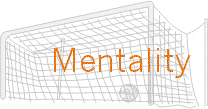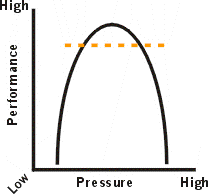“Playing, coaching and training have more
to do with the head than the legs.”

The word mentality can mean many things in youth soccer coaching. Some coaches might think of hustle and aggression while others might think of insight and creativity. This page will look at a few ideas and offer some conclusions.
The mentality in soccer must have a useful definition. In order to develop it we need to be able to say what it is and have some method of observing it. It needs to serve a useful function in the larger scheme of things. For this purpose, a working definition will be “Mentality is the level of self-confidence of a player, group or team in meeting its objectives.” With this definition, mentality is not limited to individuals but can also be viewed as a group quality. In order to meet the objectives there needs to be a clear understanding of roles, (tasks), and the ability (TIC) to meet the present.
His fellow coach Hans Westerhof also has firm opinions on the subject of self-confidence: “If you want to improve an individual player, you will have to work on his self-confidence. Self-confidence is really nothing more than knowing what it is you have to do (your basic tasks) and knowing that you can do it. The coach must send his players onto the pitch with the right basic tasks. Players must not be given orders they are unable to carry out. At the same time, however, they must not be underestimated.”5
Self-confidence groups will include a high level of communication and an agreed-upon plan. Working on group or team self-confidence is a part of the team-building process. Mentality and self-confidence play an important part when individuals try out for, (TIPS), or move to a higher level. Using this definition it becomes apparent how important it is to consider the development of the mental qualities and the other qualities of TIC.
In youth soccer, a difference can be made between a playing mentality and a winning mentality. In the former, the player is allowed to calculate on the side of risk. He can take chances, play in different positions, and express himself within broad guidelines. There will be a very low fear of failure. In the latter, he must concern himself with getting the most out of his qualities in service to the team. Opportunities to express himself are limited by the necessity to win. Developing the playing mentality is essential up to high school age. This is when children can find themselves and their role on the field. The winning mentality is important for higher-level players when the result is paramount.
Using stress to build self-confidence.

While too much stress can cause a performance breakdown, too little can lead to poor performance as well. This diagram, taken from On Soccer by Sven-Goren Eriksson and Willi Railo, shows the relationship between performance and pressure. When pressure is too little the performance level is low. There isn’t enough of a challenge. As pressure, and resistance, the performance level increases. This happens until finally, the resistance is too great, and then the performance decreases again. The job of the coach is to get the players into the top zone as often and for as long as possible. In this way, the players are exposed to the mental situations that they find in a game and can gain self-confidence through the training. This shows why small-sided games are so important. They can be easily manipulated to produce the proper level of pressure in realistic situations, something that cannot be done in drills.
Self-confidence has a ceiling and a floor
Railo and Eriksson point out that there is an upper and lower mental limit. The upper limit is the player’s ambition and is positive. It is the goal that he’s after. The lower the player’s performance anxiety. It is the “braking mechanism,” (fear of failure) that keeps many people from even attempting to achieve their goals. The ideal combination is to have high ambition, which fuels the dream with a low performance anxiety which allows the player to keep going in spite of setbacks. While coaches should strive to set reasonable ambition goals it is easier and more productive to first lower the performance anxiety level. Mistakes are all a part of the game and are necessary for growth. They are not the end of the world in youth soccer, after all, it’s just a hobby. Yet many coaches build the opposite, a mentality that fears mistakes more than desires success. They become “no-fixated instead of yes-encouraging.”7 Through overcoaching and constant criticism players develop a higher level of performance anxiety which produces extreme stress and performance drops. This, in turn reinforces the high performance anxiety and the cycle continues. These players will always be playing with “one foot on the brake.”7
Elements of self-confidence
Training self-confidence must be done on three levels. They are developing the tools and the ability to use them while under pressure. The tools are TIC, functions and the plan. What many coaches consider as coaching. The ability to use these tools is the proper measure of composure and concentration. Composure, “think, outer pace-inner calm.”7, is vital for players in reading the game and solving soccer problems. Concentration is the ability to focus on a specific problem for as long as necessary. Finally, all of this must be done in realistic situations, under the correct amount of pressure.
An important step in developing composure is to lower the anxiety level. A relaxed and confident player is a composed player. But when they play in fear they tense up which produces the fight or flight syndrome. Neither of these responses is positive. Self-confidence and concentration drop as the player becomes preoccupied with his own problems. Small-sided games provide the opportunity to confront stressful (realistic) situations in the correct proportions (not too big, fast, strong etc.) several times (repetitions.) When coupled with the correct coaching a “this isn’t so hard” frame of mind can be built while the critical moments when players lose concentration can be monitored. Taking this into account the benefits of small-sided games become apparent in developing a playing and winning mentality.
Soccer is a chaotic game. At any moment opponents have wrecked Plan A and teammates have ruined Plan B. This leaves a player with trying to invent plan C in a rapidly changing situation. Composure and self-confidence are two important qualities for bringing order out of chaos. Developing them is as important as developing passing skills and must be a part of the practice plan. Without them, players cannot rise to their highest level.
